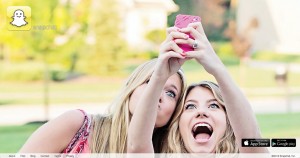SnapChat app provides free, temporary photo sharing
November 29, 2012
A revolutionary photo app entitled SnapChat was updated and released for Android and Apple products Oct. 29 with plenty of time for students on campus to become involved with the free photo sharing.
Co-founder Evan Spiegel claimed on the site’s blog that SnapChat was created in response to “emergency detagging of Facebook photos before job interviews and Photoshopping blemishes out of candid shots before they hit the Internet.”
The app allows anyone with a free membership to snap pictures, set an allotted amount of time for people to view said pictures and send to as many (or as few) friends as wanted. Upon receiving a picture, one simply clicks the message and can view it for the set amount of time. When the timer runs out, the “snap” is permanently deleted from the server, never to be viewed again and forever lost in the void of the cyber world.
“I use it to have a more personal conversation with my sister,” said Autumn McMunn, a junior. “I think this app is most beneficial to college students that are away from their families, but in my opinion, I think there is already something better: Skype.”
Though the convenience allows people to take snapshots of anything, anywhere, at anytime, the most recent release on Android allows anyone — regardless of device — to allow OpenGL, a programming interface that allows the viewer to experience the picture fullscreen.
“SnapChat is crack for sorority girls and group messaging for silly people,” said Johnna Dixon, a freshman. “It’s confusing, and if you don’t have an iPhone, it’s difficult to cross over the Android/iPhone barrier when it comes to adding contacts. I prefer trading picture messages, myself. I like that I can look back on them later when I can’t with SnapChat.”
SnapChat creators lack the capability of viewing any pictures not sent directly to them, making it impossible to recover lost images; however, the creators haven’t forgotten the power of screenshots.
“Screenshots can be captured if you’re quick, and the sender will be notified immediately,” according to SnapChat’s FAQs.
Users also have the ability to draw on their selections and submit them to drawing competitions the site holds with prizes such as gift cards.
In September, SnapChat turned a year old, and the celebration followed a battle of corrupted account data for numerous users. Though the accounts have been restored, SnapChat continues to circulate on message boards and Twitter feeds such as “The Suck Report” for not only the allowance of sending to random, unfriended accounts, but its massive number of bugs.
With the pros and cons heavily weighed, some will not use SnapChat if the app comes with a price tag.
“I wouldn’t pay for it,” Dixon said. “I rarely pay for apps, and this one isn’t exactly something that is that much different than picture messaging, so why give money to it?”
Spiegel said the one thing the application has going for it overall would be a more humane approach to communication in a society so focused on converging to the Internet.
“It seems odd that at the beginning of the Internet everyone decided everything should stick around forever,” Spiegel said. “I think our application makes communication a lot more human and natural.”












